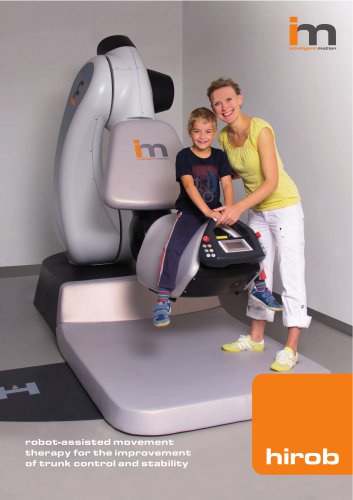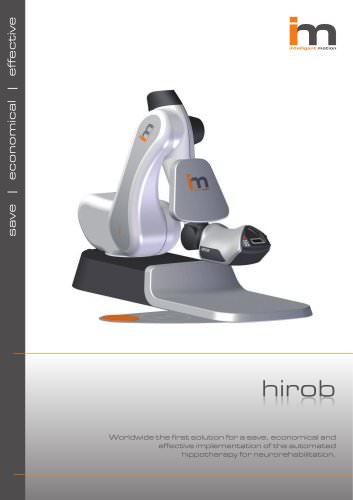
Catalog excerpts

IM-hirob: Robotic hippotherapy or improvement of impaired trunk function - preliminary results Andreas Mayr1, Michael Barth2, Markus Koer1, Leopold Saltuari1 1 Hospital Hochzirl, Department of Neurology, Hochzirl, Austria 2 intelligent motion gmbh, Linz, Austria Objectives Motor control of pelvic and trunk muscles by the central nervous system is a key issue in the treatment of impaired core stability in neurological patients. Hippotherapy provides an ideal stimulus for improving functional trunk control [1]. Its focus is on balance, trunk stability, coordination, and pelvic mobility for improvement of gait and posture [2-5]. As availability of hippotherapy for inpatients is limited, a novel robotic device has been developed for indoor application of this therapy. Methods The dynamic 3D analysis system PONTOS served to capture and reproduce a data set data set of the different types of gait of a horse. Two 1.3 million pixel cameras lmed 100 reecting targets, each 25 mm in size, from two different angles. The markers were placed on one side of the horse’s thoracic spine prior to video tracking. The length of the capturing path was 7 m in order to follow the movement of the horse during several steps. Based on prior calibration and high resolution images, the 3D coordinates of the markers were automatically calculated with subpixel accuracy. Camera position, ray intersection, and lens distortion were also taken into account. Several trials were recorded and averaged for calculation of marker displacement in x, y, and z axes. The PONTOS system created a 3D reconstruction of the markers and a dynamic 3D mesh of the captured movement. The 3D coordinates were then transformed to static points. The data set was exported as an ASCII-le, saved and transferred into the robot’s controller system. Finally, the 3D-marker set was re-engineered into a digital horseback to create the seating system. On the basis of the PONTOS 3D movement capture, a novel electronically-controlled hippotherapy robot (IM-hirob) was created. This robotic horse is an articulated robot (PUMA) with 6 axes. Each axis is equipped with a synchronous servomotor system which controls position, speed, acceleration, and torque of the particular axis every 125 μs. A mechanical braking system ensures deceleration by stopping the motors and by wedging the axes. To ensure utmost safety for patients and therapists, the robot is equipped with a special safety system comprising full redundancy of both hard- and software. A mobile terminal with graphical display and touch-screen serves as a human-machine interface. The seat of the robotic device is horseback-shaped, padded appropriately for comfort and skin safety, and is moved through the spatio-temporal trajectories of the horse’s movements. Movement of the Real Horse Ant Post Left Right Figure 1a. Horse with marker set Figure 1b. 3D model of the real horse in y- view (mash). Colours specify the current displacement of the markers from their predened zero position, at which red means far away and blue describes zero position (all other colours - yellow, green, cyan - are interpolated in between). Lines characterize the trajectory in z-axis. Gait Cycle [%] Figure 1c. Movement of the real horse in all three planes during one gait cycle (blue line shows anterior - posterior direction, grey line depicts up - down, red line displays left - right) Figure 2. IM-hirob: 1 cabinet (controller, electrical equipment and power unit of the servo drives); 2 isolating transformer; 3 PUMA robot; 4 seating system; 5 training area; 6 manipulation area; 7 optional training area Results First experience with the IM-hirob shows that the integrated movement trajectories, facility of operation allowing for creative training designs, and comfortable patient transfer provide adequate possibilities for training patients with neurological decits of pelvic and trunk control in a safe and complex manner. Evaluation of the experimental data shows that the horse robot assists improvement of trunk instability, pelvic tilt, and selective motor control of the lower trunk. In addition, mobility in the hip joint may improve. Equestrians conrm that the movement of the robot accurately simulates the gait of a living horse in all three planes. Upright Trunk Position Movement of the Horse Robot Left Right Figure 3a. Movement of the IM-hirob horse robot in all three planes (blue line shows anterior - posterior direction, grey line depicts up down, red line displays left - right) Figure 3b. The horse robot (IM-hirob) with patient Figure 3c. Trunk position of a severely affected TBI patient pre (dark green, dotted line) and after (dark green, continuous line) a three -week training period. Data show C7 movement in comparison with the calibrated horizontal line on top of the seating system. Interpretation The IM-hirob provides innovative possibilities for trunk control training in the rehabilitation program of patients with neurological disabilities of various etiology in a controlled and safe setting, requiring little physical strain on the part of the therapist. Meregillano G. Hippotherapy. Phys Med Rehabil Clin N Am 2004 Cunningham B., The effect of hippotherapy on functional outcomes for children with disabilities: a pilot study [letter]. Pediatr Phys Ther 2009 Bertoti DB. Effect of therapeutic horseback riding on posture in children with cerebral palsy. Phys Ther 1988 Shurtleff TL, Standeven JW, Engsberg JR. Changes in dynamic trunk/head stability and functional reach after hippotherapy. Arch Phys Med Rehabil 2009 Hamill D, Washington KA, White OR. The effect of hippotherapy on postural control in sitting for children with cerebral palsy. Phys Occup Ther Pediatr 2007 1th European Congress of Neurorehabilitation, Meran 2011 contact: andreas.mayr@tilak.at
Open the catalog to page 1All Intelligent Motion catalogs and technical brochures
-
Hirob
6 Pages
-
Prospekt hirob
4 Pages
-
prospect lifter
6 Pages




